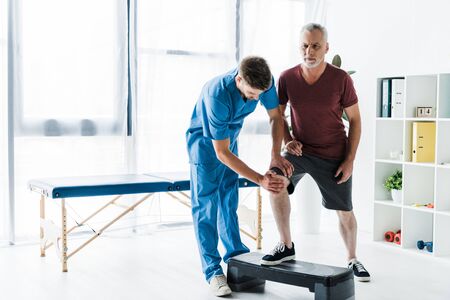Introduction to Technology in GP Practices
Across the UK, general practitioners (GPs) are increasingly embracing technology as a core component of their daily practice. The digital transformation within primary care has been particularly impactful in how GPs approach rehabilitation planning for their patients. From electronic referrals to comprehensive digital patient records, these advancements support both clinicians and patients by improving efficiency, communication, and continuity of care. As the NHS continues to encourage innovation, it is vital to understand the current landscape of technology adoption among GPs. This context not only shapes how rehabilitation services are planned and delivered but also sets the stage for ongoing improvements in patient outcomes and long-term wellbeing.
2. E-Referrals: Enhancing Coordination in Rehab
In the UK, the adoption of electronic referrals (e-referrals) is steadily transforming how GPs and rehabilitation specialists communicate and collaborate. Traditionally, referrals were made using handwritten notes or faxed forms, which could result in delays, lost paperwork, and occasional miscommunication. With the integration of e-referral systems into everyday practice, these barriers are being removed, allowing a smoother and more efficient care pathway for patients in need of rehabilitation services.
The e-referral process enables GPs to send patient information securely and instantly to relevant rehabilitation teams, whether it be physiotherapists, occupational therapists, or speech and language specialists. This digital approach not only reduces administrative burdens but also ensures that crucial clinical details are accurately transmitted, supporting better decision-making and more timely interventions.
Benefits of E-Referrals for Rehab Planning
| Aspect | Traditional Referral | E-Referral |
|---|---|---|
| Speed | Often delayed by postal or manual processing | Instant transmission to rehab specialists |
| Accuracy | Risk of misreading handwriting or losing paperwork | Clear, legible digital records reduce errors |
| Communication | Limited feedback loop between GP and specialist | Facilitates two-way updates and clarifications |
| Audit Trail | Difficult to track referral history | Comprehensive digital logs for easy follow-up |
| Patient Experience | Potentially longer waits for appointments | Smoother transitions and reduced waiting times |
This technology-driven coordination particularly resonates with the NHS’s commitment to integrated care. By leveraging e-referrals, GPs can ensure that patients receive timely access to the most appropriate rehabilitation support without unnecessary delays. Moreover, this enhanced communication means that rehabilitation plans are more closely aligned with each individual’s needs—ultimately fostering improved recovery outcomes and a more compassionate patient journey.
![]()
3. Digital Health Records: Accuracy and Continuity
One of the most significant advancements in rehabilitation planning across the UK is the integration of electronic health records (EHRs) within GP practices. EHRs have transformed how GPs and wider care teams manage patient information, providing a centralised, up-to-date resource that supports both the accuracy and continuity of care. With all relevant medical details, medication histories, and prior interventions stored securely online, GPs are now better equipped to create highly personalised rehabilitation plans tailored to each patient’s needs.
EHRs help minimise the risk of errors or omissions in documentation, which can often occur with paper-based systems. For example, allergies, medication changes, or prior physiotherapy outcomes are instantly accessible, ensuring that nothing important is overlooked when planning next steps for recovery. This meticulous record-keeping supports safer prescribing and more informed decision-making throughout the rehabilitation process.
Continuity of care is equally enhanced by digital records. Patients may move between various services—hospital consultants, community therapists, social workers—and EHRs ensure everyone involved has access to the same comprehensive information. This seamless sharing reduces duplication of assessments and prevents gaps in care that could hinder progress. In this way, EHRs enable a truly joined-up approach to rehabilitation, promoting smoother transitions and more holistic support for patients as they move forward on their recovery journey.
4. Practical Integration Challenges
The adoption of digital records and e-referrals in rehabilitation planning brings significant promise, but for GPs across the UK, these technologies come with practical hurdles that cannot be overlooked. In the context of busy NHS practices, GPs often encounter barriers when integrating new digital systems into their everyday workflows.
Common Obstacles in Everyday Practice
One of the primary challenges is ensuring interoperability between different healthcare IT systems. For example, a GP surgery in Manchester may use one electronic health record (EHR) platform, while local physiotherapy services might use another. This lack of seamless communication can result in referral delays or lost information, impacting patient care.
Examples from UK General Practice
| Challenge | Description | UK Example |
|---|---|---|
| System Compatibility | Different platforms failing to speak to each other effectively | E-referrals sent from EMIS Web not fully accessible by secondary care providers using SystmOne |
| Training & Confidence | GPs and staff require time and support to learn new systems | A practice in Kent needing extra IT support sessions during the roll-out of NHS App integrations |
| Patient Accessibility | Patients lacking digital literacy or internet access | Elderly patients in rural Cornwall struggling to use online rehab resources shared via e-referral links |
| Data Security Concerns | Ensuring patient data is protected according to UK GDPR standards | GPs in London expressing concerns over sharing sensitive rehab plans digitally between multiple providers |
Tackling These Challenges Together
Navigating these obstacles often requires a collaborative approach. Many CCGs (Clinical Commissioning Groups) are piloting integrated care records that bridge gaps between primary and secondary care. Meanwhile, ongoing training sessions help build staff confidence. For patients, offering both digital and paper-based options ensures inclusivity. With patience and shared learning, GPs across the UK can overcome these integration challenges, paving the way for more efficient and coordinated rehabilitation planning.
5. Patient Engagement and Digital Literacy
As technology becomes increasingly woven into the fabric of NHS services, GPs have a pivotal role in ensuring that all patients can confidently navigate digital platforms, especially within rehabilitation planning. The move towards e-referrals and digital records brings great promise but also necessitates mindful support for individuals who may be less familiar with these tools.
Understanding Varied Levels of Digital Literacy
Patients’ comfort with technology varies widely across the UK, influenced by factors such as age, socioeconomic background, and previous experience. Some patients may feel at ease accessing their rehabilitation plans online or communicating through patient portals, while others may find these systems daunting. Recognising these differences is the first step for GPs to provide compassionate, tailored guidance.
Strategies to Foster Accessibility
GPs can enhance accessibility by offering clear instructions, both verbally and in written form, when introducing digital systems. Simple guides or ‘how-to’ leaflets available in surgery waiting rooms or sent via post can be invaluable. Additionally, many practices now host digital literacy sessions—short workshops where staff gently walk patients through using e-referral platforms or viewing their digital health records. Such efforts ensure that no one feels left behind during their rehabilitation journey.
Encouraging Ongoing Engagement
Beyond initial introduction, continued engagement is key. GPs might consider periodic check-ins with patients to address any challenges they’re experiencing, whether it’s difficulty logging in or understanding online appointment scheduling. Encouraging questions and providing reassurance fosters trust and helps patients see the value of embracing technology as part of their recovery process.
By approaching digital integration with warmth and patience, GPs empower patients to play an active role in their rehabilitation. In doing so, they help bridge the digital divide and uphold the principles of equitable healthcare across communities throughout the UK.
6. Future Directions in Tech-Enabled Rehab Planning
As digital transformation continues to shape the landscape of healthcare across the UK, it is clear that technology’s role in rehabilitation planning is only set to expand. GPs are well-positioned at the frontline of patient care, and embracing emerging tech trends can further enhance their ability to deliver seamless, patient-centred rehabilitation services.
Integration of Artificial Intelligence and Predictive Analytics
Looking ahead, artificial intelligence (AI) and predictive analytics hold significant promise for supporting GPs in rehabilitation planning. AI-driven tools could help identify patients who are most at risk of complications or readmission, allowing for more proactive interventions. Predictive analytics may also enable tailored care pathways, based on individual health data and outcomes, ensuring that rehabilitation plans are both comprehensive and adaptive to each person’s evolving needs.
Enhanced Interoperability Between Health Systems
The future of tech-enabled rehab planning relies heavily on interoperability – the ability for different digital systems to communicate seamlessly with each other. Continued progress in this area will allow GPs, physiotherapists, occupational therapists, and community teams to share information quickly and accurately. This ensures that all professionals involved in a patient’s care have access to up-to-date records, reducing duplication and improving continuity of care across settings.
Remote Monitoring and Virtual Rehabilitation
With the rise of wearable devices and mobile health applications, remote monitoring is becoming increasingly feasible. These technologies can provide real-time feedback on patients’ progress and adherence to their rehab plans. Virtual rehabilitation platforms offer accessible support for those who might face barriers attending appointments in person—such as older adults or individuals living in rural areas—making care more inclusive and flexible.
Empowering Patients Through Digital Tools
The next wave of innovation will likely focus on empowering patients themselves. User-friendly apps, personalised digital care plans, and online educational resources can foster greater engagement, helping individuals better understand their rehabilitation journey and take an active role in managing their recovery. By fostering digital literacy and confidence among patients, GPs can ensure these tools are genuinely supportive rather than overwhelming.
Nurturing Human Connection Alongside Technology
While technological advancements bring exciting opportunities, it remains essential for GPs to balance efficiency with empathy. Digital tools should be seen as enablers—helping free up time so clinicians can focus on building trusting relationships with their patients. As we look to the future, integrating technology into rehab planning must always centre around compassionate care, ensuring every patient feels heard and supported throughout their journey towards recovery.


